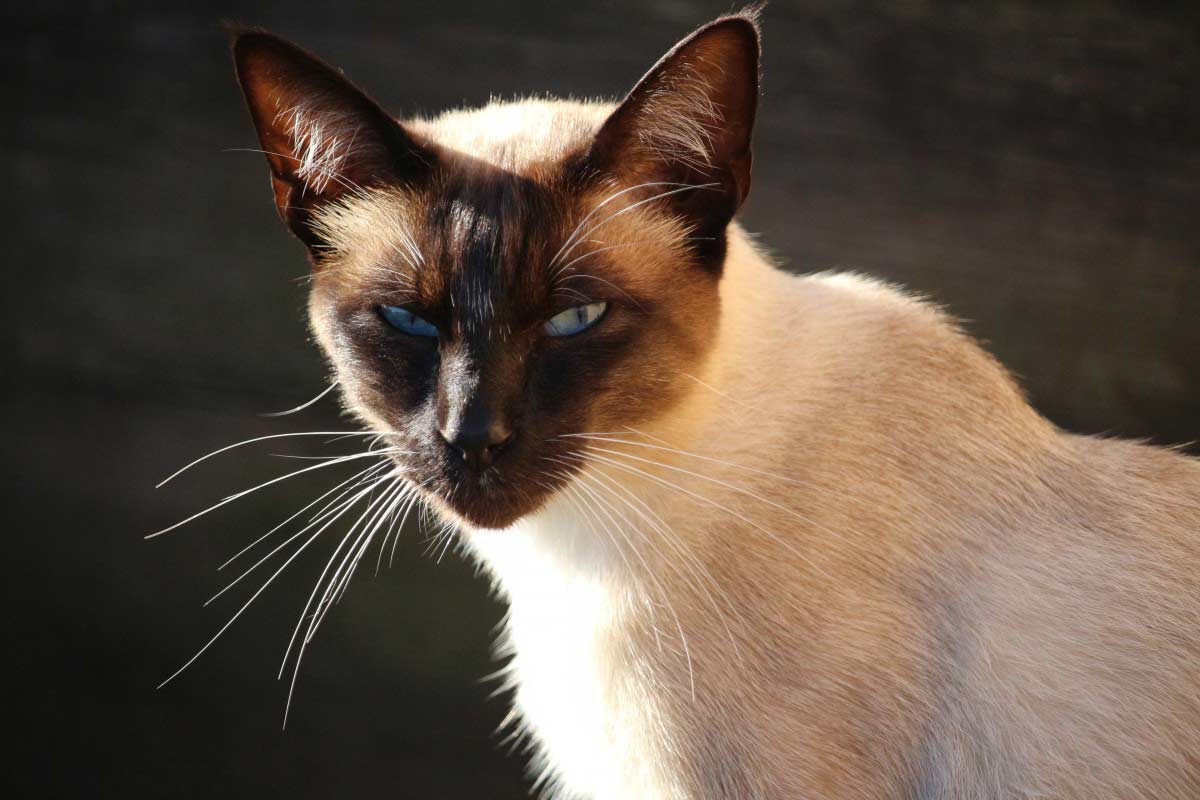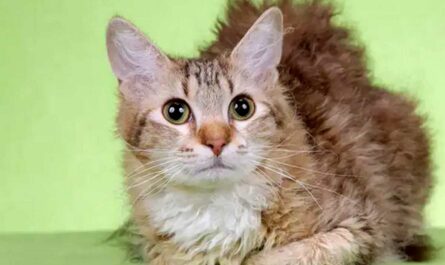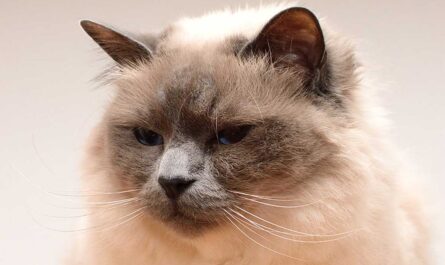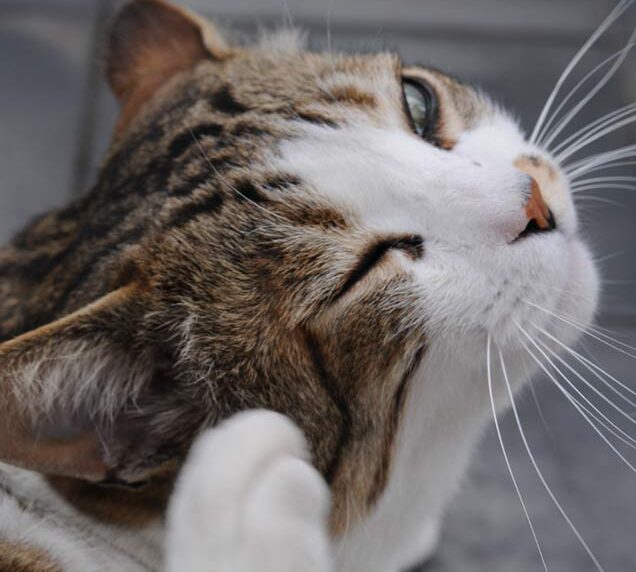What is a Snowshoe Cat Breed and what about its profile, traits, health, grooming, care, and other facts? What truly sets them apart are the dark markings adorning their ears, legs, and tail, creating an eye-catching contrast against their predominantly white or grey coat. Snowshoe cats, with their distinctive appearance and enchanting personalities, capture the hearts of cat enthusiasts worldwide. These medium-sized felines possess a unique and captivating charm, making them stand out in the feline kingdom. Their most striking feature, without a doubt, is their mesmerizing blue eyes that seem to pierce through your soul. However, it’s a remarkable fact that these cats are born entirely white, and it takes about three weeks for their colors and markings to reveal themselves, a process as unique as a snowflake, ensuring no two kittens share the same captivating appearance.
Much like their Siamese relatives, Snowshoe cats boast a diverse palette of coat colors, including enticing shades of chocolate, blue, seal, and lilac. Among these, the blue and seal variations reign as the most popular and cherished choice among devoted cat aficionados.
A Glimpse into the History of Snowshoe Cats
The Snowshoe cat’s intriguing history traces its origins to the United States in the late 1960s. The credit for developing this distinctive breed goes to Dorothy Hinds-Daugherty, a Siamese cat breeder from Philadelphia. Her journey began when three of her kittens were born with those iconic white feet, igniting her passion to create a new breed. Vikki Olander, another dedicated breeder from Virginia, joined her in this endeavor. Their collaborative efforts involved crossing Siamese cats with American Shorthairs, resulting in the Snowshoe’s unique characteristics.
In 1974, the Cat Fanciers’ Foundation recognized the Snowshoe Cat as an experimental breed. Although it didn’t immediately gain popularity, Vikki Olander’s perseverance, along with contributions from other dedicated breeders, led to the refinement of the Snowshoe’s distinctive markings. By 1982, the breed’s status evolved from experimental to provisional, and in the same year, it became eligible for champion status according to the Foundation’s standards. The remarkable journey culminated in 1990 when BirmackLowansa of Nishna became the first Snowshoe cat to attain the prestigious title of Grand Champion. Today, the Snowshoe cat has evolved to a point where it is rarely crossed with American Shorthairs, a testament to its unique and established breed characteristics.
The Snowshoe Cat: A Blend of Siamese Elegance and Domestic Short Hair Practicality
The Snowshoe cat represents a delightful amalgamation of Siamese elegance and domestic short-hair practicality. Its coat is a testament to its short and smooth texture, making it both aesthetically pleasing and easy to maintain. Shedding is moderate, ensuring that you won’t be constantly battling cat hair in your home. The unique feature that lends this breed its name is the pristine white “snowshoes” adorning their feet, an enchanting characteristic reminiscent of their wintry namesake.
Interestingly, the Snowshoe cat’s recent surge in popularity can be attributed in part to the internet sensation, Grumpy Cat, who happened to sport Snowshoe colorings. In the digital age, these charming felines have found their way into the hearts of countless individuals around the world.
Snowshoe Cat Character
Beneath their enchanting physical veneer, the Snowshoe cat reveals a character that is as tranquil as it is endearing. These felines exude an inherent calmness and an innate serenity, attributes bequeathed to them through the docility of their American Shorthair lineage. They thrive in diverse family settings, effortlessly blending into various familial ecosystems, and they are lauded for their remarkable adaptability when cohabiting with children and other fellow animals. Thus, Snowshoes emerge as the quintessential feline companion for households with a multi-species roster of pets.
Snowshoe cats extend their remarkable patience to the youngest members of the family, showering children with tolerance and benevolence. They are equally adept at engaging in playful antics and forming heartfelt bonds with these pint-sized companions. Yet, it’s important to remember that, despite their indulgence, they retain their feline nature, and overzealous handling or manipulation may not sit well with them. These cats ardently seek out positive attention, underscoring the need for an environment that fosters ample playtime and affords them a sense of inclusion within the familial milieu.
A fascinating sonic legacy from their Siamese lineage is the Snowshoe’s distinctive meow. These cats are unapologetically vocal, making their presence felt whenever a human presence looms nearby. Particularly in the case of male Snowshoes, a constant stream of meowing becomes part and parcel of daily life. It is essential to cultivate a tolerance for this vocalization, for it is merely a manifestation of their yearning for companionship and a desire to be in close proximity to their beloved human counterparts. See why thousands of cats love BoxCat
Weight and Lifespan of the Snowshoe Cat
Snowshoe cats are a study in balance, typically weighing between 2.5 and 5.5 kilograms. Males tend to be larger and more solidly built than their female counterparts. What truly sets these felines apart is their impressive longevity, with an average lifespan ranging from a remarkable 14 to 19 years. This longevity allows them to become cherished companions for those fortunate enough to share their lives.
Physical Characteristics of the Snowshoe Cat
The Snowshoe cat, an intriguing feline breed nestled halfway between the Siamese and American Shorthair, exhibits a captivating blend of attributes inherited from its venerable ancestors. The Siamese lineage bequeaths to these splendid creatures their hallmark feature – those luminous, mesmeric blue eyes that enchant observers. Additionally, a Siamese heritage bestows upon them a sleek, stylized body, boasting a triangular-shaped head adorned with distinct and eye-catching markings. The American Shorthair connection, on the other hand, contributes to the Snowshoe’s robust musculature and the unmistakable presence of dainty white socks.
In the realm of feline morphology, the Snowshoe cat gracefully occupies the medium-sized category, with their weight typically oscillating between a modest 3 to 5 kilograms. A discernible sexual dimorphism often prevails, with females tending to be slightly lighter and more diminutive than their male counterparts. These felines are the epitome of physical symmetry, sporting athletic bodies that are impeccably proportioned.
Their tails, wider at the base than at the tip, culminate in a pleasingly rounded terminus. The legs of Snowshoes, a distinguishing feature, exhibit a relative breadth and conclude in pristine, rounded white paws. Notably setting them apart from other colorpoint cats, whose extremities match their facial and tail coloring, the Snowshoe cats showcase these splendidly contrasting, white-painted paws.
The Snowshoe’s neck, standing in a state of proud elegance, contributes to their overall graceful and refined appearance. The facial visage of these regal felines forms a striking triangular shape, characterized by a sharply pointed chin. Among their most distinctive features is the ‘V’-shaped white marking gracing their visage, adding an element of mystique to their countenance. Akin to the Siamese lineage, the Snowshoe cat possesses eyes of the most entrancing glacier blue, irises that are oval in shape and grand in size, undoubtedly a testament to their Siamese heritage. Ears of medium dimensions, boasting a broad base, complete this exquisite feline package.
Moving to the realm of fur, the Snowshoe’s coat, although succinct in length, exudes a sense of opulence through its density and a tactile silkiness that beckons the touch of admirers. The accepted coat patterns for these beguiling creatures span the spectrum of colorpoint or tabby, yet these patterns must possess an unequivocal distinctiveness in relation to the rest of their body’s coloration, adding an extra layer of allure to their already captivating physicality.
Personality and Temperament: The Heartwarming Companions
One of the most endearing qualities of the Snowshoe cat is its affinity for human companionship. These felines are true “people’s cats,” relishing the company of their human family members, including children. It’s not uncommon for a Snowshoe to shadow their owners around the house, engaging in vocal exchanges that seem almost like conversations, creating an atmosphere of lively interaction. They tend to be social creatures and are not particularly fond of being left alone for extended periods. For households with other animals, this breed can easily adapt, or having two Snowshoe cats can be a mutually beneficial arrangement.
Interestingly, Snowshoe cats are not averse to the company of dogs and can even be trained to play fetch, adding an element of playfulness to their already engaging personalities. Their love for games and interaction makes them ideal companions for families seeking an active and affectionate pet, one that seamlessly integrates into the tapestry of family life.
Snowshoe Cat Care
While the Snowshoe cat boasts a short coat that might seem low-maintenance, the absence of an undercoat means that they may not require as much rigorous grooming as their fluffier counterparts. A judicious weekly brushing regimen, supplemented by sporadic baths only when necessity dictates, should suffice to keep their fur in impeccable condition.
However, in the realm of general Snowshoe cat care, our diligence should extend beyond the aesthetics of their fur. Vigilance should extend to their oral hygiene as well. Snowshoes, in particular, have been known to grapple with dental issues, mandating a dedicated approach to dental care.
Employing a feline dental hygiene kit intermittently to clean their teeth becomes a necessity in maintaining their overall health. While daily brushing may not be obligatory, periodic attention to oral hygiene is paramount. Additionally, their ears warrant scrutiny, necessitating checks for mites and vigilant observation of any parasitic interlopers that might seek refuge in their luxurious fur.
Ensuring the Snowshoe’s well-being hinges upon the provision of a balanced diet of premium quality, tailored to meet their energy and nutritional needs comprehensively. Incorporating daily exercise into their routine assumes paramount importance, especially if these felines are primarily indoor-dwellers.
To satiate their need for physical and mental stimulation, conscientious environmental enrichment becomes pivotal. Scratching posts, an array of toys, intelligence-boosting games, and other stimulating objects should be thoughtfully integrated into their living space to ensure their holistic well-being. Cat accessories on Amazon
Common Snowshoe Cat Diseases & Conditions: A Caretaker’s Guide
Caring for a Snowshoe cat also involves being aware of potential health issues. Feline lower urinary tract disease (FLUTD) is a condition that can affect the bladder and urethra. Cats with FLUTD may exhibit symptoms such as pain during urination, increased frequency of urination, and the presence of blood in their urine. Excessive genital licking or random urination around the house could also be signs. Due to the possibility of recurring symptoms, consulting a veterinarian is advisable.
Vomiting, a concern for many cat owners, can result from various causes, ranging from eating too quickly to more severe conditions like bacterial infections, gastrointestinal obstructions, or organ failures. In cases of violent and frequent vomiting, prompt veterinary attention is essential.
Feline viral rhinotracheitis, caused by feline herpesvirus 1 (FHV-1), presents as respiratory symptoms, including coughing, sneezing, and watery eyes. Kittens are particularly susceptible, and stress can trigger outbreaks in carriers. Monitoring and managing this condition is crucial for your Snowshoe’s well-being.
Another ailment to be mindful of is progressive retinal atrophy, a group of eye conditions leading to gradual vision loss. Night vision is the first to be affected, followed by daytime vision deterioration. Although cats are remarkably adaptable, maintaining a consistent environment can help them cope better with this condition.
Fascinating Tidbits About Snowshoe Cats
Snowshoe cats are renowned for their vocal nature, making them one of the most expressive and “talkative” breeds. They take pride in letting their owners know exactly what’s on their feline minds.
The official Facebook page of the internet sensation Grumpy Cat boasts a staggering 6 million “likes.” Grumpy Cat, whose real name is Tardar Sauce, became a household name with her unique Snowshoe colorings.
Snowshoe cats are not fans of solitude. If you’re frequently away from home for extended periods, this breed might not be the ideal choice for you. They thrive on companionship and interaction, making them perfect for families or those with other pets. See why thousands of cats love BoxCat

FAQs
1. What breeds make a Snowshoe cat?
The Snowshoe cat is a captivating feline breed known for its distinctive appearance and charming personality. This breed is an intriguing blend of two distinct pedigrees: the Siamese and the American Shorthair. The Snowshoe’s genetic heritage combines the grace and elegance of the Siamese cat with the robust and adaptable traits of the American Shorthair, resulting in a unique and captivating feline companion.
2. What is a Snowshoe cat mixed from?
The Snowshoe cat, with its beguiling characteristics, emerges from a fascinating genetic cocktail. Its ancestry traces back to the crossing of the Siamese cat, renowned for its striking blue almond-shaped eyes and distinct coat coloration, with the American Shorthair, known for its robust build, endurance, and diverse coat patterns. This genetic fusion has bestowed the Snowshoe with its distinct traits, making it a truly exceptional and visually arresting breed.
3. How do you describe a Snowshoe cat?
Describing a Snowshoe cat is akin to painting a portrait of feline elegance. These enchanting creatures are characterized by their medium-sized, well-proportioned bodies, adorned with a sleek coat boasting contrasting colors. Most strikingly, their paws are a snowy white, resembling dainty “snowshoes,” while their faces exhibit the Siamese influence with striking blue eyes, a wedge-shaped head, and charmingly large ears. Their personality is equally enchanting, known for being sociable, affectionate, and intelligent, making them ideal companions for those seeking a loving feline friend.
4. How do I know if my kitten is a Snowshoe?
Determining if your adorable kitten is indeed a Snowshoe requires a keen eye for their distinct physical traits. First and foremost, observe the fur on their paws; the telltale sign of a Snowshoe is the white “snowshoes” on their otherwise colored paws. Additionally, their striking blue almond-shaped eyes and a coat with color points similar to a Siamese cat are indicative of their breed. A vet’s consultation or a pedigree certificate can also provide definitive confirmation.
5. Is Snowshoe a color or breed?
Snowshoe is not merely a color but a unique and captivating cat breed. While their name might suggest a focus on their snowy paws, Snowshoe cats are distinct due to their Siamese heritage, which contributes to their color pointation, and their American Shorthair ancestry, which influences their overall build and temperament. Thus, they are a distinct breed with a striking appearance that sets them apart from others.
6. Is a Snowshoe a rare cat?
Snowshoe cats, with their enchanting appearance and charming personalities, are considered a relatively rare breed within the feline world. The limited population of Snowshoes, coupled with their unique genetic heritage, contributes to their rarity. However, their popularity is steadily growing, thanks to their endearing traits, making them increasingly sought after by cat enthusiasts and admirers of exceptional feline companions.
7. Do Snowshoe cats meow?
Snowshoe cats are not only visually captivating but are also known for their melodious voices. They are vocal and expressive, much like their Siamese ancestors. Snowshoes are likely to engage in delightful conversations with their human companions, using their meows and purrs to convey their emotions and desires. Their charming vocalizations add to their overall appeal as affectionate and communicative pets.
8. Are Snowshoe cats loud?
While Snowshoe cats are certainly vocal and enjoy engaging in conversations, they are not excessively loud or disruptive. Their meows are often described as melodious and sweet, making them a pleasant addition to any household. Their vocalizations are a means of expressing themselves and connecting with their human counterparts, rather than being overly noisy or bothersome.
9. How do I know if my cat is a Snowshoe or Siamese?
Distinguishing between a Snowshoe and a Siamese cat can be challenging due to their shared Siamese ancestry. However, Snowshoes can be identified by the presence of their distinctive white paws or “snowshoes,” which Siamese cats typically lack. Additionally, Snowshoes tend to have a slightly stockier build compared to the slender Siamese. Consulting a veterinarian or breed expert can provide a definitive answer.
10. Are Snowshoe cats loyal?
Snowshoe cats are renowned for their loyalty and affection towards their human companions. They form deep bonds and thrive on human interaction. These felines are known to follow their owners around, offering companionship and unconditional love. Their loyalty makes them excellent family pets, as they often become deeply attached to all members of the household.
11. Are Snowshoe cats easy to train?
Snowshoe cats are not only loving but also highly intelligent, which makes them amenable to training. They quickly grasp concepts and can be taught tricks and commands with patience and positive reinforcement. Their eager-to-please nature and intelligence make them a joy to train, and they often enjoy mental stimulation through interactive games and challenges.
12. Are Snowshoe cats cute?
The inherent charm of Snowshoe cats often leads people to describe them as incredibly cute. With their striking blue eyes, contrasting coat colors, and unmistakable white paws, they exude an undeniable cuteness that captivates cat lovers worldwide. Their endearing appearance is matched by their sweet personalities, adding to their overall appeal.
13. Do Snowshoe cats talk a lot?
Snowshoe cats are known for their vocal nature and can indeed be quite chatty. They enjoy engaging in conversations with their human companions, using a variety of meows, purrs, and trills to communicate. However, the extent of their vocalization can vary from one individual to another, with some being more talkative than others. Cat accessories on Amazon
14. Do Snowshoe cats swim?
While many cats have an aversion to water, Snowshoe cats are not particularly known for their love of swimming. Their distinctive white paws may make them more aware of water’s effects on their fur, and they often prefer to stay dry. However, like all cats, there can be exceptions, and some Snowshoes may show a curiosity about water or tolerate it to some extent.
15. Are Snowshoe cats soft?
Snowshoe cats have a sleek and soft coat that adds to their overall appeal. The texture of their fur is often described as velvety, and it lies close to their bodies, giving them a luxurious and touchable quality. Petting a Snowshoe cat is a delightful experience, as their soft fur is a source of comfort and pleasure for both the cat and its owner.
16. What cats are super soft?
While Snowshoe cats are known for their soft and velvety fur, several other cat breeds are also renowned for their exceptionally soft coats. These include the Ragdoll, the Persian, and the British Shorthair, all of which boast plush and luxurious fur that invites touch and cuddling. The softness of a cat’s coat can vary from individual to individual, adding to the uniqueness of each feline companion.
17. Are Snowshoe cats low maintenance?
Snowshoe cats are generally considered to be relatively low-maintenance pets. Their short coat requires minimal grooming, and they are known for their cleanliness. However, like all cats, they do need proper care, including regular feeding, litter box maintenance, and veterinary check-ups. Their sociable nature also means they thrive on human interaction, so providing them with love and attention is essential for their well-being.
18. Do Snowshoe cats have extra toes?
Snowshoe cats, unlike some other breeds like the Polydactyl or Hemingway cats, do not typically have extra toes. They usually possess the standard number of toes on their paws, with no genetic predisposition to polydactyly. While extra-toed cats are intriguing in their own right, Snowshoe cats are known for their distinctive white paws rather than extra digits.
19. Why are Snowshoe cats so expensive?
Snowshoe cats can be relatively expensive due to several factors. First, their rarity plays a role; as a less common breed, they may come with a higher price tag. Additionally, responsible breeding practices, health screening, and the care required for raising healthy Snowshoe kittens contribute to the overall cost. Their unique appearance and charming personalities also make them highly sought after, further influencing their market value.
In conclusion, Snowshoe cats are not merely feline companions; they are a captivating blend of history, personality, and unique characteristics. Their striking appearance, engaging demeanor, and fascinating history make them a breed worth celebrating and cherishing.
More Interesting Articles
- 13 Very Interesting Facts About an Orange Tabby Cat
- Maine Coon Cat Breed: Traits, Profile, Personality, Facts
- 13 Interesting Fun Facts about Siamese Cats & Kittens
- 7 Amazing Light Brown (Beige) Cream Cat Breeds
- 10 Amazing Blue Cat Breeds with Short or Long Hair
- 11 Interesting Facts about a Cream Cute Tabby Cat
- 13 Common Symptoms of A Dead Kitten Inside A Cat
- Neutering Male Cats: Behavior and Recovery Guide
- How to Help a Choking Cat: Signs, Precautions, Tips
- Cat Dry Heaving: Cat Gagging Causes and What to Do
- Why is My Cat Panting? Symptoms, and Treatment
- 26 Tips How to Train A Cat Not to Scratch You or Anything
- Everything You Need to Know about Owning A Cat: 23 Facts
- How to Easily Train Your Cat to Use Toilet in One Week
- 10 Steps How to Train A Kitten to Use A Litter Box in a Week
- 10 Tips How to Train A Cat to Walk On a Leash in A Week
- 6 Steps How to Train A Cat Not to Bite Your Hand or Skin
- 6 Steps How to Get My Cat to Stop Jumping on the Counter
- 8 Tips on Introducing A New Dog To A Cat Step By Step
- 27 Tips How to Train An Outdoor Cat to Stay Home



